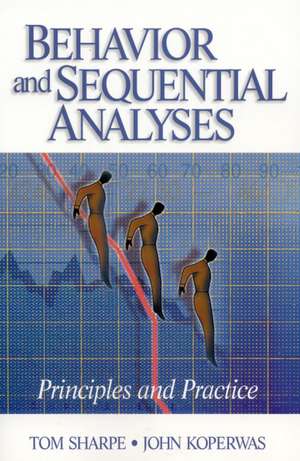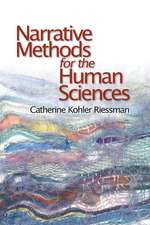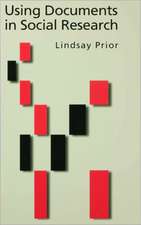Behavior and Sequential Analyses: Principles and Practice
Autor Thomas L. Sharpe, John Koperwasen Limba Engleză Paperback – 24 mar 2003
Preț: 560.56 lei
Preț vechi: 728.01 lei
-23% Nou
Puncte Express: 841
Preț estimativ în valută:
107.27€ • 114.70$ • 89.43£
107.27€ • 114.70$ • 89.43£
Carte tipărită la comandă
Livrare economică 18 aprilie-02 mai
Preluare comenzi: 021 569.72.76
Specificații
ISBN-13: 9780761925606
ISBN-10: 0761925600
Pagini: 384
Dimensiuni: 152 x 229 x 21 mm
Greutate: 0.51 kg
Ediția:New.
Editura: SAGE Publications
Colecția Sage Publications, Inc
Locul publicării:Thousand Oaks, United States
ISBN-10: 0761925600
Pagini: 384
Dimensiuni: 152 x 229 x 21 mm
Greutate: 0.51 kg
Ediția:New.
Editura: SAGE Publications
Colecția Sage Publications, Inc
Locul publicării:Thousand Oaks, United States
Recenzii
"Sharpe and Koperwas provide a methodological framework that objectifies the complexity of behavior. This book’s quantitative and multiple-event approach to data collection and analysis is essential for effective descriptions and explanations of the behavior of humans and nonhumans. Of particular note is the multidisciplinary applicability of the methodology and that the methods can be used by basic, applied, and clinical researchers. Human service providers are being increasingly pressured to take objective measures; practitioners should find much in this book to help them satisfactorily meet these demands. The authors’ sensitivity to clarity of presentation makes the book an excellent primary or supplementary text for any course in behavior methodology."
"I think the author did a very thoughtful, informed analysis and presentation of his view of research methodology."
"I think the author did a very thoughtful, informed analysis and presentation of his view of research methodology."
Cuprins
ABOUT THE AUTHORS
DEDICATION
FOREWORD BY TOM SHARPE
PART I: BEHAVIOR ANALYSIS: HISTORY AND INTRODUCTION
CHAPTER ONE: History and Evolution
Terms and Study Guide
A Brief History of Behavior Analysis
Science as a Direct Observation, Descriptive Enterprise
Toward a Multiple Research Method Compatibility Theory
Some Myths About Behavior Analysis Debunked
Overview of Behavior Analysis Principles and Practice Overview Overview Overview Overview Overview
CHAPTER TWO: A Behavior and Sequential Analyses Primer
Terms and Study Guide
Some Introductory Terms
Behavior Analysis Unpacked
Foundations of Field Systems and Sequential Analyses
Behavior Alayisis as a Descriptive/Explanatory Enterprise
How Behavior Analysis Conceptualized Mental Events An Endnote on "Feelings" and Metaphysical Explanations An Endnote on "Feelings" and Metaphysical Explanations An Endnote on "Feelings" and Metaphysical Explanations
CHAPTER THREE: An Interbehavioral Multi-Event Perspective
Terms and Study Guide
From Science to Technology
Differences in Assessment: Modeling an Interbehavioral Lens Differences in Assessment: Modeling an Interbehavioral Lens Differences in Assessment: Modeling an Interbehavioral Lens
Multi-Event Theory in the Applied Sciences Multi-Event Theory in the Applied Sciences Multi-Event Theory in the Applied Sciences Multi-Event Theory in the Applied Sciences Multi-Event Theory in the Applied Sciences
The Implications of Computer Technology
Some Assumptions and Limitations
A Preface to Behavior Analysis Methodology
PART II: CONSTRUCTING OBSERVATIONAL SYSTEMS
CHAPTER FOUR: Constructing a Coding Scheme
Terms and Study Guide
A Preface to Category System Construction
Defining Purposes
Determining Observation System Characteristics
Recording Physical Versus Social Coding Schemes
How to Construct Operational Definitions
CHAPTER FIVE: Inderdisciplinary Examples and Illustrations
Terms and Study Guide
A General Framework for Developing a Coding Scheme
Examples From Teacher Education
Examples From School Psychology
Examples From Special Education
An Illustration From Clinical Psychology
A Systems Code From Ethology
CHAPTER SIX: Reliability and Staff Training
Terms and Study Guide
The Purposes of Assessment
The Issue of Data Accuracy
A Recommended Three-Step Reliability Process
Treatment Fidelity
Reliability Formula Summaries
Summary and Foreground for Part III
PART III: RECORDING TACTICS, DESIGN TYPES, AND DATA ANALYSIS
CHAPTER SEVEN: Approaches to Recording Direct Observational Data
Terms and Study Guide
Measurement Options
Traditional Recording Methods
Recording in Real Time
CHAPTER EIGHT: Constructing an Appropriate Research Design
Terms and Study Guide
Validity Issues
The Simplest Case: An ABAB Design
The Multiple Baseline Design
Additional Design Options
Design Choice Summary
CHAPTER NINE: Analyzing Observational Data
Terms and Study Guide
Preparing a Graph
Visual Inspection
The Challenge of Statistical Analyses
Some Recommendations Regarding Statistical Analyses
Sequential Analyses
An Endnote on Sequential Data
PART IV: APPLICATION ILLUSTRATIONS AND A WINDOW TO THE FUTURE
CHAPTER TEN: Measurably Superior Instruction and Therapy
Terms and Study Guide
A Return to the Counting of Things?
Research and Development Opportunities
Instruction and Evaluation
Laboratory Applications
APPENDIX A: SEQUENTIAL ANALYSIS FORMULAE
APPENDIX B: BEHAVIOR EVALUATION STRATEGY AND TAXONOMY (BEST) SOFTWARE
REFERENCES
DEDICATION
FOREWORD BY TOM SHARPE
PART I: BEHAVIOR ANALYSIS: HISTORY AND INTRODUCTION
CHAPTER ONE: History and Evolution
Terms and Study Guide
A Brief History of Behavior Analysis
Science as a Direct Observation, Descriptive Enterprise
Toward a Multiple Research Method Compatibility Theory
Some Myths About Behavior Analysis Debunked
Overview of Behavior Analysis Principles and Practice Overview Overview Overview Overview Overview
CHAPTER TWO: A Behavior and Sequential Analyses Primer
Terms and Study Guide
Some Introductory Terms
Behavior Analysis Unpacked
Foundations of Field Systems and Sequential Analyses
Behavior Alayisis as a Descriptive/Explanatory Enterprise
How Behavior Analysis Conceptualized Mental Events An Endnote on "Feelings" and Metaphysical Explanations An Endnote on "Feelings" and Metaphysical Explanations An Endnote on "Feelings" and Metaphysical Explanations
CHAPTER THREE: An Interbehavioral Multi-Event Perspective
Terms and Study Guide
From Science to Technology
Differences in Assessment: Modeling an Interbehavioral Lens Differences in Assessment: Modeling an Interbehavioral Lens Differences in Assessment: Modeling an Interbehavioral Lens
Multi-Event Theory in the Applied Sciences Multi-Event Theory in the Applied Sciences Multi-Event Theory in the Applied Sciences Multi-Event Theory in the Applied Sciences Multi-Event Theory in the Applied Sciences
The Implications of Computer Technology
Some Assumptions and Limitations
A Preface to Behavior Analysis Methodology
PART II: CONSTRUCTING OBSERVATIONAL SYSTEMS
CHAPTER FOUR: Constructing a Coding Scheme
Terms and Study Guide
A Preface to Category System Construction
Defining Purposes
Determining Observation System Characteristics
Recording Physical Versus Social Coding Schemes
How to Construct Operational Definitions
CHAPTER FIVE: Inderdisciplinary Examples and Illustrations
Terms and Study Guide
A General Framework for Developing a Coding Scheme
Examples From Teacher Education
Examples From School Psychology
Examples From Special Education
An Illustration From Clinical Psychology
A Systems Code From Ethology
CHAPTER SIX: Reliability and Staff Training
Terms and Study Guide
The Purposes of Assessment
The Issue of Data Accuracy
A Recommended Three-Step Reliability Process
Treatment Fidelity
Reliability Formula Summaries
Summary and Foreground for Part III
PART III: RECORDING TACTICS, DESIGN TYPES, AND DATA ANALYSIS
CHAPTER SEVEN: Approaches to Recording Direct Observational Data
Terms and Study Guide
Measurement Options
Traditional Recording Methods
Recording in Real Time
CHAPTER EIGHT: Constructing an Appropriate Research Design
Terms and Study Guide
Validity Issues
The Simplest Case: An ABAB Design
The Multiple Baseline Design
Additional Design Options
Design Choice Summary
CHAPTER NINE: Analyzing Observational Data
Terms and Study Guide
Preparing a Graph
Visual Inspection
The Challenge of Statistical Analyses
Some Recommendations Regarding Statistical Analyses
Sequential Analyses
An Endnote on Sequential Data
PART IV: APPLICATION ILLUSTRATIONS AND A WINDOW TO THE FUTURE
CHAPTER TEN: Measurably Superior Instruction and Therapy
Terms and Study Guide
A Return to the Counting of Things?
Research and Development Opportunities
Instruction and Evaluation
Laboratory Applications
APPENDIX A: SEQUENTIAL ANALYSIS FORMULAE
APPENDIX B: BEHAVIOR EVALUATION STRATEGY AND TAXONOMY (BEST) SOFTWARE
REFERENCES
Notă biografică
Tom Sharpe teaches at the University of Nevada-Las Vegas. He draws from varied experiences and settings: teaching at public and private schools, coaching, and education and social science work at Research Institutions. Trained at a leading behavior analysis program (West Virginia University), he has pursued academic work in observational methods as applied to education and the social sciences and in related computer-based tool development. He has authored over 75 refereed articles and book chapters and additionally contributes to the principles and practice of applied behavior analysis through conference and workshop presentations and consulting activities.
Descriere
This book provides a step-by-step approach to the principles and practices of direct observation and behaviour analysis research and evaluation procedures. The book contains references to software resources, including the BEST and BESTPCC data collection and analysis package developed by the authors, highlighting technological innovations in methods for this field. BEST is distributed by Scolari, the software division of SAGE Publications (www.scolari.co.uk).













